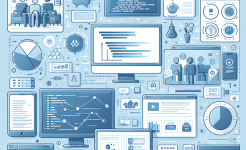Clear Vision and Goals
A well-defined vision and set of goals are the foundation of any successful agile iterative development project. The vision provides a high-level understanding of what the product is intended to achieve and why it matters. It gives the team a sense of direction and purpose, guiding their decisions throughout the development process. Without a clear vision, the team may end up working on features that do not align with the overall product strategy, resulting in wasted time and effort.
The goals, on the other hand, are specific, measurable, achievable, relevant, and time-bound (SMART). They break down the vision into actionable steps that the team can work towards in each iteration. Clear goals help the team prioritize their work, allocate resources effectively, and track their progress. They also provide a way to measure the success of the project and determine whether the desired outcomes have been achieved.
To ensure that the vision and goals are clear, it is essential to involve all stakeholders in the process. This includes the product owner, developers, testers, and any other individuals who have a vested interest in the project. By collaborating and communicating effectively, the team can gain a shared understanding of the vision and goals, and work together to achieve them.
Cross-Functional Teams
Agile iterative development thrives on the concept of cross-functional teams. These teams consist of individuals with diverse skills and expertise, including developers, designers, testers, and business analysts. By bringing together different perspectives and skill sets, cross-functional teams can solve complex problems more effectively, make better decisions, and deliver higher-quality products.
In a cross-functional team, each member has a specific role and responsibility, but they also work closely together to achieve the common goals of the project. The developers are responsible for writing the code, the designers for creating the user interface, the testers for ensuring the quality of the product, and the business analysts for understanding the requirements and communicating them to the team. By working in parallel and collaborating continuously, the team can reduce the time and effort required to complete the project.
One of the key benefits of cross-functional teams is their ability to adapt quickly to changing requirements. Since the team members have a broad range of skills and knowledge, they can easily switch gears and work on different tasks as needed. This flexibility allows the team to respond to feedback from stakeholders and make adjustments to the product in a timely manner.
To build an effective cross-functional team, it is important to select team members who have the right skills and attitude. They should be passionate about their work, willing to learn, and able to collaborate effectively with others. It is also essential to provide the team with the necessary resources and support to enable them to work together efficiently.
Continuous Communication
Communication is a crucial factor in the success of any agile iterative development project. In an agile environment, where requirements can change frequently and the team is working in short cycles, effective communication is essential to ensure that everyone is on the same page and working towards the same goals.
Continuous communication involves keeping all stakeholders informed about the progress of the project, sharing ideas and feedback, and resolving issues in a timely manner. This can be achieved through a variety of channels, including daily stand-up meetings, sprint planning sessions, retrospectives, and regular status reports.
The daily stand-up meeting is a short, daily meeting where the team members gather to discuss their progress, any obstacles they have encountered, and what they plan to work on next. This meeting provides an opportunity for the team to stay aligned, share information, and address any issues that may be blocking progress.
Sprint planning sessions are held at the beginning of each sprint to plan the work that will be done during the sprint. During this session, the team reviews the product backlog, selects the items that will be included in the sprint, and breaks them down into smaller tasks. The team also estimates the effort required to complete each task and assigns them to team members.
Retrospectives are held at the end of each sprint to reflect on the team's performance and identify areas for improvement. During this session, the team members discuss what went well during the sprint, what didn't go well, and what actions they can take to improve their performance in the next sprint.
Regular status reports are used to keep stakeholders informed about the progress of the project. These reports provide an overview of the work that has been completed, any issues that have been encountered, and the status of the project against the planned schedule and budget.

To ensure that communication is effective, it is important to establish clear communication channels and protocols. The team should agree on how and when they will communicate, what information will be shared, and who will be responsible for communicating it. It is also essential to encourage open and honest communication, and to create a culture of trust and respect within the team.
Customer Involvement
Customer involvement is a critical success factor in agile iterative development. By involving the customer in the development process, the team can gain a better understanding of their needs and expectations, and ensure that the product meets their requirements.
In an agile environment, the customer is typically represented by the product owner. The product owner is responsible for defining the product vision, prioritizing the product backlog, and working closely with the team to ensure that the product meets the customer's needs.
The product owner should be actively involved in the development process, providing feedback and guidance to the team on a regular basis. This can include reviewing the work that has been completed, providing input on new features and functionality, and helping the team to understand the customer's perspective.
In addition to the product owner, it is also beneficial to involve other customers or end-users in the development process. This can be done through user testing, beta testing, or other forms of customer feedback. By getting feedback from real users, the team can identify any issues or areas for improvement in the product, and make the necessary adjustments before it is released.
Customer involvement also helps to build a strong relationship between the team and the customer. By working closely together, the team can gain a better understanding of the customer's business and goals, and develop a product that meets their specific needs. This can lead to increased customer satisfaction, loyalty, and repeat business.
To ensure that customer involvement is effective, it is important to establish clear communication channels and expectations. The team should work closely with the product owner to understand the customer's needs and priorities, and to ensure that their feedback is incorporated into the development process. It is also essential to provide the customer with regular updates on the progress of the project, and to involve them in key decisions.
Continuous Improvement
Continuous improvement is a fundamental principle of agile iterative development. It involves constantly reviewing and evaluating the team's processes, practices, and performance, and making adjustments to improve them over time.
In an agile environment, continuous improvement is achieved through a process of inspection and adaptation. The team regularly inspects their work and processes to identify any issues or areas for improvement. They then adapt their processes and practices to address these issues and improve their performance.
One of the key tools for continuous improvement in agile iterative development is the retrospective. As mentioned earlier, the retrospective is a meeting held at the end of each sprint to reflect on the team's performance and identify areas for improvement. During this meeting, the team members discuss what went well during the sprint, what didn't go well, and what actions they can take to improve their performance in the next sprint.
In addition to retrospectives, the team can also use other techniques and tools to support continuous improvement. This can include process audits, code reviews, and performance metrics. By regularly reviewing and analyzing these data, the team can identify trends and patterns, and make informed decisions about how to improve their processes and practices.
Continuous improvement also requires a culture of learning and innovation within the team. The team members should be encouraged to experiment with new ideas and techniques, and to share their knowledge and experiences with others. By fostering a culture of continuous learning, the team can stay ahead of the curve and deliver high-quality products that meet the changing needs of the customer.
To ensure that continuous improvement is effective, it is important to establish a clear process and framework for it. The team should define the goals and objectives of continuous improvement, and establish a process for identifying, prioritizing, and implementing improvement opportunities. It is also essential to provide the team with the necessary resources and support to enable them to implement these improvements.
In conclusion, agile iterative development offers many benefits, but achieving success requires careful attention to several key factors. By having a clear vision and goals, building cross-functional teams, communicating continuously, involving the customer, and focusing on continuous improvement, teams can increase their chances of delivering high-quality products that meet the needs of the customer. These success factors are not only important for the success of individual projects, but also for the long-term success of the organization. By adopting these principles and practices, organizations can become more agile, innovative, and competitive in today's rapidly changing business environment.
ARTICLE TITLE :5 key success factors in agile iterative development ,AUTHOR :ITpmlib

















